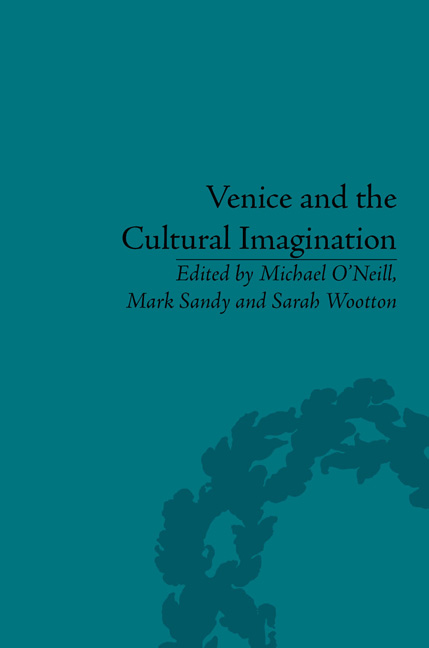Book contents
- Frontmatter
- CONTENTS
- Acknowledgements
- List of Figures
- Notes on Contributors
- Introduction
- 1 A ‘More Beloved Existence’: From Shakespeare's ‘Venice’ to Byron's Venice
- 2 Reimagining Venice and Visions of Decay in Wordsworth, the Shelleys and Thomas Mann
- 3 J. M. W. Turner and the ‘Floating City’
- 4 Venice and Opera: Tradition, Propaganda and Transformation
- 5 Venice, Dickens, Robert Browning and the Victorian Imagination
- 6 ‘The Lamp of Memory’: Ruskin and Venice
- 7 Edith Wharton's ‘Venetian Backgrounds’
- 8 Henry James's Venice and the Visual Arts
- 9 The Myth of Venice in the Decline of Eliot and Pound
- 10 Representations of Venice in Daphne du Maurier's Don't Look Now and Nicolas Roeg's Screen Adaptation
- Notes
- Select Bibliography
- Index
9 - The Myth of Venice in the Decline of Eliot and Pound
- Frontmatter
- CONTENTS
- Acknowledgements
- List of Figures
- Notes on Contributors
- Introduction
- 1 A ‘More Beloved Existence’: From Shakespeare's ‘Venice’ to Byron's Venice
- 2 Reimagining Venice and Visions of Decay in Wordsworth, the Shelleys and Thomas Mann
- 3 J. M. W. Turner and the ‘Floating City’
- 4 Venice and Opera: Tradition, Propaganda and Transformation
- 5 Venice, Dickens, Robert Browning and the Victorian Imagination
- 6 ‘The Lamp of Memory’: Ruskin and Venice
- 7 Edith Wharton's ‘Venetian Backgrounds’
- 8 Henry James's Venice and the Visual Arts
- 9 The Myth of Venice in the Decline of Eliot and Pound
- 10 Representations of Venice in Daphne du Maurier's Don't Look Now and Nicolas Roeg's Screen Adaptation
- Notes
- Select Bibliography
- Index
Summary
nothing matters but the quality
of the affection –
in the end – that has carved the trace in the mind
(Ezra Pound, Canto 76)The stones of Venice carved a very deep trace in the mind of Ezra Pound. They figure in his poetry from beginning to end. Arriving in the city in 1908 at the age of twenty-two – fresh from Crawfordsville, Indiana – he penned these lachrymose lines:
the beauty of this thy Venice
hast thou shown unto me
Until is its loveliness become unto me
a thing of tears.
These sentiments are borne along by watery currents of aestheticism:
And before the holiness
Of the shadow of thy handmaid
Have I hidden mine eyes,
O God of waters.
(‘Night Litany’)
After four months of unemployed idling in Dorsoduro, two overlooking the gondola workshop in Rio di San Trovaso, courtesy of Sara Norton's prepaid lodgings, Pound took his leave from Venice bearing his first volume of poems, A Lume Spento (‘with tapers quenched’ a phrase drawn from Dante), 150 copies published at his own expense:
Ne'er felt I parting from a woman loved
As feel I now my going forth from thee,
Yea, all thy waters cry out ‘Stay with me!’
And laugh reflected flames up luringly.
(‘Partenza di Venezia’)
In his recent critical biography, David Moody describes the poems contained in Pound's ‘San Trovaso Notebook’ as saturated by a ‘high-toned mood of “art and ecstasy”’.
- Type
- Chapter
- Information
- Venice and the Cultural Imagination'This Strange Dream upon the Water', pp. 141 - 156Publisher: Pickering & ChattoFirst published in: 2014



